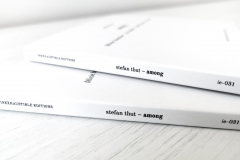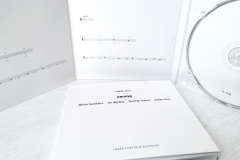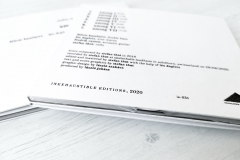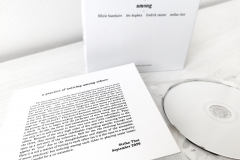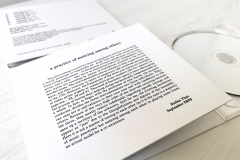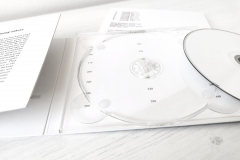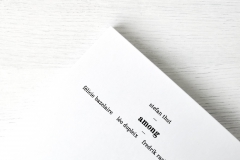Stefan Thut – Among
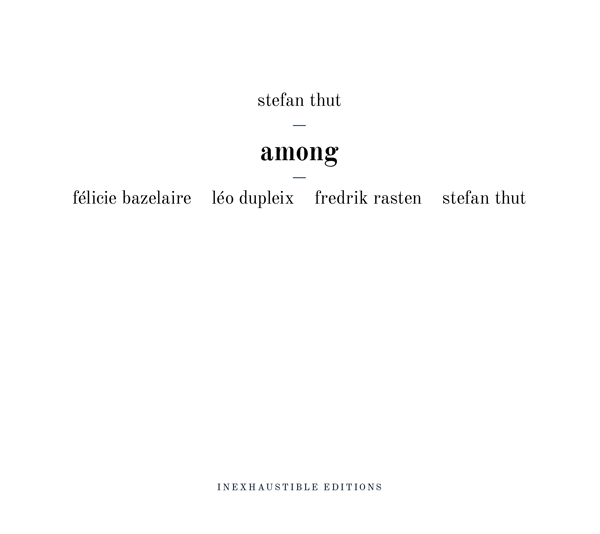
1. Among I (6:40)
2. Among II (7:18)
3. Among III (8:36)
4. Among IV (7:21)
5. Among V (8:08)
6. Among VI (6:26)
7. Among VII (7:15)
· Félicie Bazelaire: double bass
· Léo Dupleix: sine waves
· Fredrik Rasten: acoustic guitar
· Stefan Thut: cello
Score composed by Stefan Thut in 2018
Recorded by Stefan Thut at Säulenhalle Landhaus in Solothurn, Switzerland on 28/06/2020
Edited and mastered by Stefan Thut with the help of Léo Dupleix
Text and score graphics by Stefan Thut
Graphic design by László Szakács
Produced by László Juhász
a practice of noticing among others
The piece among is scored for three string players and sine waves which a fourth performer is responsible for. Aside of the usual purposes the three string instruments – in the present version a double bass, an acoustic guitar and a cello – also serve as resonating bodies for loudspeakers: the sine waves are sounding by means of transducers attached to the three wooden boxes. The instrumentalists attune initially to their respective sine wave, and then continue in ratios of imaginary odd-numbered partials up to the 17th. However, the frequencies of the three sine waves are multiples of either prime triplets or other prime numbers like for instance on page one – 23, 29 and 37. This kind of harmonic space is more obfuscating the process of tuning than making things harmonically comprehensible as a whole. In fact, to begin with the performer of sine waves, the acoustic conductor, divides the three instrumentalists into three individuals. They can only act in self-reliance to their own tone and with confidence to the others. Because of the very high order of the intervals occuring between the three, they mostly remain indefinable regarding specific tunings and open up a territory of the unknown. Still for me, the evolving harmonies appear as “just” due to the thoughtfulness and dignity of the ensemble. Here it is not a matter of tuning to each other (as it is the case in a majority of music practices) but noticing among each other in playing some tones: an actual model for a co-existence.
Stefan Thut
September 2020
Released: October 2020 / first edition of 300 cds
Direct purchase: Bandcamp / Discogs
GALLERY ↓
REVIEWS ↓
“Az Among album négy hangszeres különleges zenei uniója és összpontosító szimbiózisa. Egy ilyen jellegű anyagnál el kell különíteni kissé a célokat és a hangszeres döntéseket, valamint a végül összeálló összhangzást. Az egyik nem értelmezhető a másik nélkül, mégis távolság van közöttük. E három absztrakt fogalom közti szűk ösvény végigjárásával érthetjük meg, és hallhatjuk teljes komplexitásában ezt az amúgy szűkszavú és nagyon szikár nagylemezt.
Az albumborító és az érzés, amit sugároz, a funkcionalitás, a vizuális minimum, előrevetítik mit is vár el a hallgatótól az anyag. A zenehallgatás ebben az esetben nem puszta passzív részvétel, sokkal inkább egy gondolati koreográfia végigjárása audio-hatások vezénylete alatt. A borító belső oldalán olvasható szinopszis textualitásában és vizualitásában is ezt a precíz fegyelmet sugallja: az egymás értő figyelése képes csökkenteni a zenészek közti teret. Egy komplex gondolat csak nagyfokú koncentrációval szólaltatható meg ilyen limitált gesztusú rendszerben, négy ember által teljes szinkronban.
A munkát, aminek a finomhangolása az egész lemezen végigfut, a konceptuális művészethez tudnám igazán hasonlítani: félúton helyezkedik el Maria Abramović érzelmeken és taktilitáson alapuló munkája és Ai Weiwei letisztult adat- és ideológia-vizualizációja között. A pontos kalibráltság és adatrendek ismerete egyensúlyban van a zenei intuíciók megengedésével. Az alapok a szinusz hullámok, amik útjukra indulnak a tételek kezdetén, és később több hullámban csatlakoznak rá erre az áramlásra a hangszerek. A mozgástér körülhatároltsága impozáns, a 230 Hz és 440 Hz között változó alap további szabályok szerint koreografálja a zenészek mozdulatait. Talán a kötött improvizáció jellemezné ezt az albumot, de ez is csak egy közelítés. Az improvizáció inkább gesztusában jelenik meg a zenei döntésekben; nem önmagukban való elmerülés vagy a zenei változásokra való reflexió a cél.
Hallgatva a tételeket, nem egymásra reflektálás vagy zenei kommunikáció a cél, hanem hogy egyes hangszerek olyan folyamatokat járjanak be, ami a második, harmadik, negyedik hangszerest is jó tonális helyzetbe hozza, és a darab fluiditását elősegítse, mint egy tehertámasz rendszer. Ez a szövevényesnek ható folyamat tovább árnyalódik, hogy nem a produkált hang minősége, íve vagy karaktere számít, sokkal inkább a pozicionálása. Az adott zenei tér kitöltése a megfelelő számú hanggal, időzítéssel és a lehető legmagasabb fokú audio egalizálással. Maga a hang meta-szerkezete a rezonancia, és annak tonális következményei a meghatározóak. Ezt a fontossági sorrendet támasztja alá az is, hogy minden instrumentum fatestű húros hangszer.
A rezonancia, ami az alapot adja, így hat a hangszerekre is, nem csak a hangszert használóra, aki céljainak megfelelően kezeli az eszközt. Így egy folyamatos fizikai kontroll is megvalósul már anyagszerkezeti szinten is. A zárt rendszerben való gondolkodás előrevetíti az előadás minőségi tőkesúlyát és a precizitás lehetőségét. Ezek a részletek és adalék információk együttesen adják meg azt a komplex élményt, amit a hét tétel képes kiváltani a hallgatóból. Erre az élményre lett kalibrálva az egész folyamat, így joggal jelenthetjük ki, hogy egy kötött improvizációs jegyeket hordozó konceptuális munkáról beszélünk, aminek hang alapú a bemutatása, mégis önálló munkaként is megállná a helyét.
Túlzónak tűnhet ez a fajta többrétegű értelmezés, de a modern, nagyon is többdimenziós vagy intermediális zeneszerzés csak így érthető, élhető át abban a kontextusban, ahogyan az megfogant a szerzőben. Ez persze a befogadótól időt és törődést kíván, mégis megéri, mert a zene élvezete mellett egy személyes élménnyel és megértéssel lehetünk gazdagabbak.” / Sós Gergő, Improv.hu, 25 October 2020
“Немного растеряв в последний год интерес к музыке вокруг Wandelweiser, я приятно удивляюсь почти всем релизам от швейцарца Стефана Тута. Правда, оговорочка есть – с ним я не раз работал, и знаю некоторую внутреннюю кухню, которая очень любопытна мне. Вот и релиз с ним мы делали, играли и выпускали на Intonema.
Можно почитать хорошее интервью про записанную пьесу. Она исполнена квартетом с французами и норвежцем, все моего возраста, ощутимо младше Стефана. Пьеса эта звучит в духе классической, мелодической ветви вандельвайзеров, с длинными нотами, созвучиями, биениями. В целом вроде и ничего нового, а слушается на ура, и явно музыканты были полны энтузиазма. Кстати, это случилось в конце июня 2020-го, когда вроде как вирус отступил немного, и может быть вот этот порыв соскучившихся музыкантов и придал записи такое органичное и прекрасное настроение?” / Илья Белоруков, Telegram, 5 January 2021
“As if to emphasise the breadth and variety of Thut’s music, Among is completely different to Atama, both in its conception and execution. (Anyone noting a certain pattern in Thut’s album titles – About, Atama, Among – should note that the Wandelweiser website also lists Thut compositions entitled Along, Apart, Around, Away, Amidst… One is reminded of the late, great Steve Lacy’s penchant for single-word album titles beginning with ‘s’.)
Recorded in Solothurn, in June 2020, Among features a seven-part piece which Thut composed in 2018, scored for three string players – double bass, acoustic guitar and cello – and a fourth player who was responsible for sine waves. The album sleeve includes images of parts of the score plus a sleeve note, entitled ‘a practice of noticing among others’, in which Thut explains his methodology and thinking behind the piece. Each of the instruments also served as the resonating body for a loudspeaker; sine waves were sounded by means of transducers attached to the three wooden boxes of the instruments. Each player initially attuned to the sine wave from their instrument. The sleeve lists these sine waves’ frequencies for the seven parts – 230, 290 and 370; 140, 220 and 260… As these frequencies are multiples of either prime triplets or consecutive prime numbers, the three players were effectively individuals who ‘can only act in self-reliance to their own tone and with confidence to the others’.
If that sounds like a recipe for anarchy and/or cacophony, rest assured that the reality is very different, with the musicians – Thut included – producing impressively rich music based largely on sustained tones which interweave and complement one another beautifully. As the seven parts of the composition – which range in duration from six-and-a-half to eight-and-a-half minutes – each have different frequency initial sine waves for the players, there is enough variety across the piece to make it both engaging and satisfying. All credit to Thut and his fellow musicians for an impressive achievement which demands to be heard again and again…” / John Eyles, All About Jazz, 24 January 2021
“A group of four musicians is needed to perform the piece by Stefan Thut, who is one of the performers here, playing the cello. Félicie Bazelaire plays the double bass, Fredrik Rasten the acoustic guitar and Léo Dupleix controls the sine waves. The cover describes the process behind these seven pieces, which is not easy to summarize in a few words, so I copy a longer bit: ‘The piece among is scored for three string players and sine waves which a fourth performer is responsible for. Aside from the usual purposes the three string instruments – in the present version a double bass, an acoustic guitar and a cello – also serve as resonating bodies for loudspeakers: the sine waves are sounding employing transducers attached to the three wooden boxes. The instrumentalists attune initially to their respective sine wave and then continue in ratios of imaginary odd-numbered partials up to the 17th. However, the frequencies of the three sine waves are multiples of either prime triplets or other prime numbers like for instance on page one – 23, 29 and 37. This kind of harmonic space is more obfuscating the process of tuning than making things harmonically comprehensible as a whole”. The sine waves do not seem to play a large role in the music, or are very low in volume, whereas the three string instruments play rather carefully on top of that. Music in slow motion could have been the subtitle for this. All of these pieces are subtle interactions with both the instruments and with each other. Each plays a small curve and these curves are different from each other so that all of these small cycles intertwine differently all the time, and maybe that is down to that thing described with the prime numbers? I don’t know. Like the previous, I would say this one is definitely in the world of modern classical music, minimal and yet also something from the world of improvised music. Odd but great!” / Frans de Waard, Vital Weekly, 20 April 2021
“From Switzerland we have the cellist Stefan Thut, Wandelweiser collective member, who we heard on Un/even And One which was recorded in Russia and released on Intonema in 2016, an unusual affair made from cello sounds, sine waves, and something to do with rubbing cardboard boxes. There was also Two Strings And Boxes from 2012, made with fellow Wandelweiser player Johnny Chang, a record so quiet and empty it defeated the critical responses of Paul Khimasia Morgan.
He’s here today with Among, which he composed in 2018, and performed it in 2020 with the help of Félicie Bazelaire (double bass), Léo Dupleix (sine waves) and Fredrik Rasten (acoustic guitar). This label often signal when we’re in the ‘serious and minimal’ arena with a cover that’s shorn of all content, save a white background and stark black printing in lower-case letters. As you may know I have personally struggled with appreciating much of the combined Wandelweiser efforts over many years, though certain efforts by Bruno Duplant have provided me with a glimmer of hope, likewise the recent brushes between Michael Pisaro and the Insub players. At least Among is relatively accessible, there is a good deal of content, and though it may be deathly slow and solemn it’s not completely inaudible, nor is it playing games with ‘silence’ that tend to disrupt our normal listening pleasure. No denying also the ingenuity and innovation of Stefan Thut’s work here. If I understand it, the structure of Among is very far from a conventional score of notes and harmonies, and is based on the principles of numbered partials to be found in a vibrating sine wave. The string players are required to tune to a sine wave, and ‘proceed in ratios’ based on a succession of mathematical formulae (multiple, prime numbers). There’s also something to do with the very physical nature of the instruments, acting as resonating bodies for sound waves in the performance space.
I’m barely able to grasp much of this, but it’s clear that our man Thut has a very clear and precise grasp of numbers and how they can relate to intervals and harmonics in music, or be used to help understand them. I am dimly aware that Helmholtz (in the 19th century) was a pioneer in describing acoustic resonance and could express it in terms of maths formulae, and his work was cited by minimalist Charlemagne Palestine (for one). For the composer personally, one success of Among is demonstrated by the ‘thoughtfulness and dignity of the ensemble’ who played it; it’s something about ‘noticing’ each other, a process which to him is more important than players simply tuning their instruments together. Well! When we think of the years musicians have wasted on things like co-operation, interaction, playing in harmony, staying in tune, keeping in time – all things requiring tremendous effort and craft and communicative skills – when all along they could have settled for just ‘noticing’ each other. Still, I should not sneer nor carp. Stefan Thut believes he may have found ‘an actual model for a co-existence’, a model which, in today’s world of unceasing strife and conflict when any sort of co-existence looks increasingly impossible, can only be perceived as a good thing.” / Ed Pinsent, The Sound Projector, 6 January 2022
“Silence in music is never actual silence. What seems like empty space is full of sounds from the surrounding world, a la 4’33”. This mesmerizing work from cellist Stefan Thut uses his instrument along with guitar, bass, and sine waves. The acoustic instruments also resonate from the sine waves, adding an unpredictable and natural sound element even when they’re not being played.” / George Grella, Bandcamp Daily, 10 March 2025
RADIO PLAYS ↓
· Glasni Novi Svet at ARS – 3. Program Radia Slovenija, Ljubljana, 5 January 2022
· The Sound Projector Radio Show at Resonance FM, London, 21 January 2022

